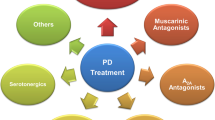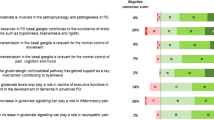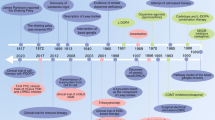Abstract
For many years, levodopa has given most patients with Parkinson's disease excellent symptomatic benefit. This agent does not slow down the progression of the disease, however, and it can induce motor fluctuations and dyskinesias in the long term. The other available antiparkinsonian agents also have drawbacks, and as a consequence research into antiparkinsonian drugs is expected to take new and different directions in the coming years. The most promising approaches include the development of 'neuroprotective' drugs that are capable of blocking or at least slowing down the degenerative process that is responsible for cellular death; 'restorative' strategies intended to restore normal brain function; more-effective agents for replacing dopamine loss; and symptomatic and antidyskinetic drugs that act on neurotransmitters other than dopamine or target brain areas other than the striatum. In this Review, we discuss the numerous drugs in development that target the primary motor disorder in Parkinson's disease.
Key Points
-
Several new drugs for neuroprotection in Parkinson's disease are being developed, but human studies have not yet demonstrated a clear disease-modifying effect
-
New compounds have been developed that improve levodopa bioavailability and synaptic availability of dopamine
-
Novel non-dopaminergic drugs might be useful for their symptomatic antiparkinsonian effects
-
Levodopa-induced dyskinesia might also be ameliorated by new drugs acting on the glutamatergic, noradrenergic or serotonergic systems
This is a preview of subscription content, access via your institution
Access options
Subscribe to this journal
Receive 12 print issues and online access
$209.00 per year
only $17.42 per issue
Buy this article
- Purchase on Springer Link
- Instant access to full article PDF
Prices may be subject to local taxes which are calculated during checkout
Similar content being viewed by others
References
Nutt JG and Holford NH (1996) The response to levodopa in Parkinson's disease: imposing pharmacological law and order. Ann Neurol 39: 561–573
Colosimo C and De Michele M (1999) Motor fluctuations in Parkinson's disease: pathophysiology and treatment. Eur J Neurol 6: 1–21
Colosimo C et al. (1996) The motor response to acute dopaminergic challenge with apomorphine and levodopa in Parkinson's disease: implications or the pathogenesis of the on-off phenomenon. J Neurol Neurosurg Psychiatry 61: 634–637
Brotchie JM (2000) The neural mechanisms underlying levodopa-induced dyskinesia in Parkinson's disease. Ann Neurol 47 (Suppl 1): S105–S114
Bezard E et al. (2001) Pathophysiology of levodopa-induced dyskinesia: potential for new therapies. Nat Rev Neurosci 2: 577–588
Bedard PJ et al. (1992) Levodopa-induced dyskinesia: facts and fancy. What does the MPTP monkey model tell us? Can J Neurol Sci 19: 134–137
Pearce RKB et al. (1998) De novo administration of ropinirole and bromocriptine induces less dyskinesia than LD in the MPTP-treated marmoset. Mov Disord 13: 234–241
Rascol O et al. (2000) A five-year study of the incidence of dyskinesia in patients with early Parkinson's disease who were treated with ropinirole or levodopa. 056 Study Group. N Engl J Med 342: 1484–1491
Parkinson Study Group (2004) Pramipexole vs levodopa as initial treatment for Parkinson disease: a 4-year randomized controlled trial. Arch Neurol 61: 1044–1053
Colosimo C et al. (1994) Clinical usefulness of apomorphine in movement disorders. Clin Neuropharmacol 17: 243–259
Brown RG and Marsden CD (1990) Cognitive function in Parkinson's disease: from description to theory. Trends Neurosci 13: 21–29
Senard JM et al. (2001) Orthostatic hypotension in patients with Parkinson's disease: pathophysiology and management. Drugs Aging 18: 495–505
Bloem BR et al. (2004) Falls and freezing of gait in Parkinson's disease: a review of two interconnected, episodic phenomena. Mov Disord 19: 871–884
Pinto S et al. (2004) Treatments for dysarthria in Parkinson's disease. Lancet Neurol 3: 547–556
Wint DP et al. (2004) Psychosis in Parkinson's disease. J Geriatr Psychiatry Neurol 17: 127–136
Brotini S and Gigli GL (2004) Epidemiology and clinical features of sleep disorders in extrapyramidal disease. Sleep Med 5: 169–179
Johnston TH and Brotchie JM (2004) Drugs in development for Parkinson's disease. Curr Opin Investig Drugs 5: 720–726
Johnston TH and Brotchie JM (2006) Drugs in development for Parkinson's disease: an update. Curr Opin Investig Drugs 7: 25–32
Dawson TM and Dawson VL (2003) Molecular pathways of neurodegeneration in Parkinson's disease. Science 302: 819–822
Hirsch EC et al. (1999) Dopaminergic neurons degenerate by apoptosis in Parkinson's disease. Mov Disord 14: 383–385
Ravina BM et al. (2003) Neuroprotective agents for clinical trials in Parkinson's disease: a systematic assessment. Neurology 60: 1234–1240
Pålhagen S et al. (2006) Selegiline slows the progression of the symptoms of Parkinson disease. Neurology 66: 1200–1206
Parkinson Study Group (2002) A controlled trial of rasagiline in early Parkinson's disease (the TEMPO study). Arch Neurol 59: 1939–1943
Parkinson Study Group (2004) A controlled, randomized, delayed start study of rasagiline in early Parkinson's disease. Arch Neurol 61: 561–566
Shults CW et al. (2002) Effects of coenzyme Q10 in early Parkinson disease: evidence for slowing of the functional decline. Arch Neurol 59: 1541–1550
Matthews RT et al. (1999) Creatine and cyclocreatine attenuate MPTP neurotoxicity. Exp Neurol 157: 142–149
NINDS NET-PD Investigators (2006) A randomized, double-blind, futility clinical trial of creatine and minocycline in early Parkinson disease. Neurology 66: 664–671
Currie LJ et al. (2004) Postmenopausal estrogen use affects the risk of Parkinson disease. Arch Neurol 61: 886–888
Dluzen D and Horstink M (2003) Estrogens as neuroprotectant of nigrostriatal dopaminergic system: laboratory and clinical studies. Endocrine 21: 67–75
Schneider JS (1998) GM1 ganglioside in the treatment of Parkinson's disease. Ann NY Acad Sci 845: 363–373
Nobile Orazio E et al. (1994) Gangliosides: their role in clinical neurology. Drugs 47: 576–585
Gold BG and Nutt JG (2002) Neuroimmunophilin ligands in the treatment of Parkinson's disease. Curr Opin Pharmacol 2: 82–86
Poulter MO et al. (2004) Neuroimmunophilins: a novel drug therapy for the reversal of neurodegenerative disease? Neuroscience 128: 1–6
Eberling JL et al. (2002) The immunophilin ligand GPI-1046 does not have neuroregenerative effects in MPTP-treated monkeys. Exp Neurol 178: 236–242
Lund S et al. (2005) Inhibition of microglial inflammation by the MLK inhibitor CEP-1347. J Neurochem 92: 1439–1451
Parkinson Study Group (2004) The safety and tolerability of a mixed lineage kinase inhibitor (CEP-1347) in PD. Neurology 62: 330–332
Du Y et al. (2001) Minocycline prevents nigrostriatal dopaminergic neurodegeneration in the MPTP model of Parkinson's disease. Proc Natl Acad Sci USA 98: 1469–1474
Steiger MJ et al. (1991) The clinical efficacy of oral levodopa methyl ester solution in reversing afternoon “off” periods in Parkinson's disease. Clin Neuropharmacol 14: 241–244
Nyholm D et al. (2005) Duodenal levodopa infusion monotherapy vs oral polypharmacy in advanced Parkinson disease. Neurology 64: 216–223
Pearce RK et al. (2002) The monoamine reuptake blocker brasofensine reverses akinesia without dyskinesia in MPTP-treated and levodopa-primed common marmosets. Mov Disord 17: 877–886
Bara-Jimenez W et al. (2004) Effect of monoamine reuptake inhibitor NS2330 in advanced Parkinson's disease. Mov Disord 19: 1183–1186
Treatments in the PD pipeline: Parkinson pipeline project [http://www.pdpipeline.org/yy_treatmentdev/treatment_list_2.htm#discontinued] (accessed 8 September 2006)
Rascol O et al. (1999) ABT-431, a D1 receptor agonist prodrug, has efficacy in Parkinson's disease. Ann Neurol 46: 736–741
Rascol O et al. (2001) Induction by dopamine D1 receptor agonist ABT-431 of dyskinesia similar to levodopa in patients with Parkinson disease. Arch Neurol 58: 249–254
Bezard E et al. (2003) Attenuation of levodopa-induced dyskinesia by normalizing dopamine D3 receptor function. Nat Med 9: 762–767
Stephenson DT et al. (2005) The effects of a selective D2 receptor agonist on behavioral and pathologic outcome in MPTP-treated squirrel monkeys. J Pharmacol Exp Ther 314: 1257–1266
Fabbrini G et al. (1988) Motor fluctuations in Parkinson's disease: central pathophysiological mechanisms part I. Ann Neurol 24: 366–371
Olanow CW et al. (2006) Drug Insight: continuous dopaminergic stimulation in the treatment of Parkinson's disease. Nat Clin Pract Neurol 2: 382–392
Metman LV et al. (2001) Continuous transdermal dopaminergic stimulation in advanced Parkinson's disease. Clin Neuropharmacol 24: 163–169
Parkinson Study Group (2003) A controlled trial of rotigotine monotherapy in early Parkinson's disease. Arch Neurol 60: 1721–1728
Woitalla D et al. (2004) Transdermal lisuride delivery in the treatment of Parkinson's disease. J Neural Transm Suppl 68: S89–S95
Wolf WA (2003) SLV-308: Solvay. Curr Opin Investig Drugs 4: 878–882
Fariello RG et al. (1998) Preclinical evaluation of PNU-151774E as a novel anticonvulsant. J Pharmacol Exp Ther 285: 397–403
Stocchi F et al. (2004) Improvement of motor function in early Parkinson disease by safinamide. Neurology 63: 746–748
Kanda T et al. (1998) Adenosine A2A antagonist: a novel antiparkinsonian agent that does not provoke dyskinesia in parkinsonian monkeys. Ann Neurol 43: 507–513
Kostic VS et al. (1999) Theophylline increases “on” time in advanced parkinsonian patients. Neurology 52: 1916
Kulisevsky J et al. (2002) A double-blind crossover, placebo-controlled study of the adenosine A2A antagonist theophylline in Parkinson's disease. Clin Neuropharmacol 25: 25–31
Hauser RA et al. (2003) Istradefylline US-001 Study Group: randomized trial of the adenosine A2A receptor antagonist istradefylline in advanced PD. Neurology 61: 297–303
Results of phase-III clinical studies of an anti-Parkinson's disease drug istradefylline (KW-6002) conducted overseas [http://www.leaddiscovery.co.uk/prlink.asp?reclink=http://www.kyowa.co.jp/eng/netext/er060307.htm] (accessed 8 September 2006)
Papa SM et al. (1999) Internal globus pallidus discharge is nearly suppressed during levodopa induced dyskinesias. Ann Neurol 46: 732–738
Colosimo C and Craus A (2003) Noradrenergic drugs for levodopa-induced dyskinesia. Clin Neuropharmacol 26: 299–305
Gomez-Mancilla B and Bèdard PJ (1993) Effect of nondopaminergic drugs on L-dopa-induced dyskinesias in MPTP-treated monkeys. Clin Neuropharmacol 16: 418–427
Chase TN et al. (2000) Antiparkinsonian and antidyskinetic activity of drugs targeting central glutamatergic mechanisms. J Neurol 247 (Suppl 2): S36–S42
Metman LV et al. (1998) Amantadine as treatment for dyskinesias and motor fluctuations in Parkinson's disease. Neurology 50: 1323–1326
Snow BJ et al. (2000) The effect of amantadine on levodopa-induced dyskinesias in Parkinson's disease: a double-blind, placebo-controlled study. Clin Neuropharmacol 23: 82–85
Thomas A et al. (2004) Duration of amantadine benefit on dyskinesia of severe Parkinson's disease. J Neurol Neurosurg Psychiatry 75: 141–143
Steece-Collier K et al. (2000) Antiparkinsonian actions of CP-101,606, an antagonist of NR2B subunit-containing N-methyl-D-aspartate receptors. Exp Neurol 163: 239–243
Scheinin M et al. (1994) Distribution of α2-adrenergic receptor subtype gene expression in rat brain. Brain Res Mol Brain Res 21: 133–149
Hill MP and Brotchie JM (1999) The adrenergic receptor agonist, clonidine, potentiates the anti-parkinsonian action of the selective kappa-opioid receptor agonist, enadoline, in the monoamine-depleted rat. Br J Pharmacol 128: 1577–1585
Reisine TD et al. (1982) A role for striatal beta-adrenergic receptors in the regulation of dopamine release. Brain Res 241: 123–130
Burn DJ (2002) Depression in Parkinson's disease. Eur J Neurol 9 (Suppl 3): S44–S54
Chopin P et al. (1986) The effects of yohimbine on exploratory and locomotor behavior are attributable to its effects at noradrenaline and not at benzodiazepine receptor. Neuropharmacology 25: 53–57
Savola JM et al. (2003) Fipamezole (JP-1730) is a potent alpha-2-adrenergic receptor antagonist that reduces levodopa-induced dyskinesia in the MPTP-lesioned primate model of Parkinson's disease. Mov Disord 18: 872–883
Carpentier AF et al. (1996) Improvement of levodopa-induced dyskinesia by propranolol in Parkinson's disease. Neurology 46: 1548–1551
Henry B et al. (1999) The alpha2-adrenergic receptor antagonist idazoxan reduces dyskinesia and enhances anti-parkinsonian actions of L-dopa in the MPTP-lesioned primate model of Parkinson's disease. Mov Disord 14: 744–753
Rascol O et al. (2001) Idazoxan, an alpha-2 antagonist, and L-DOPA-induced dyskinesias in patients with Parkinson's disease. Mov Disord 16: 708–713
Manson AJ et al. (2000) Idazoxan is ineffective for levodopa-induced dyskinesia in Parkinson's disease. Mov Disord 15: 336–337
Bezard E et al. (2003) Presymptomatic compensation in Parkinson's disease is not dopamine-mediated. Trends Neurosci 26: 215–221
Bibbiani F et al. (2001) Serotonin 5-HT1A agonist improves motor complications in rodent and primate parkinsonian models. Neurology 57: 1829–1834
Olanow CW et al. (2004) Open-label trial of sarizotan in Parkinson disease patients with levodopa-induced dyskinesias (the SPLENDID Study). Clin Neuropharmacol 27: 58–62
Bara-Jimenez W et al. (2005) Effects of serotonin 5-HT1A agonist in advanced Parkinson's disease. Mov Disord 20: 932–936
Kumar SP and Smith PE (2004) Levetiracetam as add-on therapy in generalised epilepsies. Seizure 13: 475–477
Bezard E et al. (2003) Novel antiepileptic drug levetiracetam decreases dyskinesia elicited by L-dopa and ropinirole in the MPTP-lesioned marmoset. Mov Disord 18: 1301–1305
Zesiewicz TA et al. (2005) Open-label pilot study of levetiracetam (Keppra) for the treatment of levodopa-induced dyskinesias in Parkinson's disease. Mov Disord 20: 1205–1209
Lyons KE and Pahwa R (2006) Efficacy and tolerability of levetiracetam in Parkinson disease patients with levodopa-induced dyskinesia. Clin Neuropharmacol 29: 148–153
Acknowledgements
The authors thank W Poewe and O Rascol for their data about ongoing trials in PD.
Author information
Authors and Affiliations
Corresponding author
Ethics declarations
Competing interests
The authors declare no competing financial interests.
Rights and permissions
About this article
Cite this article
Colosimo, C., Fabbrini, G. & Berardelli, A. Drug Insight: new drugs in development for Parkinson's disease. Nat Rev Neurol 2, 600–610 (2006). https://doi.org/10.1038/ncpneuro0340
Received:
Accepted:
Issue Date:
DOI: https://doi.org/10.1038/ncpneuro0340



